#the bruce partington plans 1988
Text
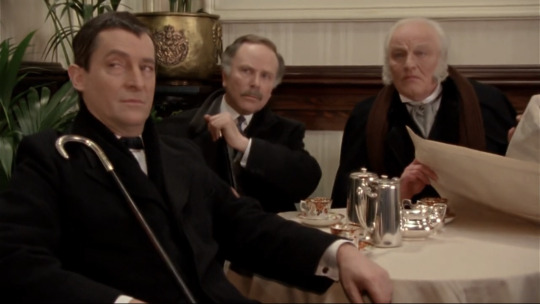
#this screencap is so hilarious to me#daily dose of granada holmes#daily granada screencap#sherlock holmes 1984#the bruce partington plans 1988#jeremy brett holmes#edward hardwicke watson#granada holmes#sherlock holmes#jeremy brett#edward hardwicke#sherlock holmes granada#dr john watson#john watson#acd holmes#acd sherlock holmes#acd watson#acd john watson#victorian husbands#mycroft holmes#new reaction image just dropped
317 notes
·
View notes
Text

Help this looks like they both are admiring your plant @seeingteacupsindragons


[picture of Holmes and Watson from @jazzandpizazz]
#victorian husbands#daily dose of granada holmes#sherlock holmes 1984#the bruce partington plans 1988#jeremy brett holmes#edward hardwicke watson#sherlock holmes#dr john watson#john watson
11 notes
·
View notes
Text
The Bruce-Partington Plans
Published in 1908, this is one from the His Last Bow collection. The international context i.e. the growing tensions with Germany, should be borne in mind when reading this.
This is the second and final appearance of Mycroft Holmes in the canon.
This is our third Violet! ACD likes the name, clearly.
This video shows the development of the Underground over time. The 1894 map does not include some of the then "mainline" services, like the one going up to Epping and Ongar, that would be incorporated into the network later on.
The Woolwich Arsenal was a massive munitions factory and research site located on the south bank of the Thames. It peaked in size during the First World War and then declined after that. It ceased being a factory in 1967 and stopped being a military site in 1994. Much of the site has been redeveloped - the Eastern half becoming Thamesmead - or repurposed.
Both attempts at a museum on the site were short-lived, sadly.
Woolwich Arsenal station is today served by the Docklands Light Railway and Southeastern trains; the Elizabeth Line station at Woolwich is a 200m walk away.
The most notable cultural legacy of the site was its works football team. Originally called Dial Square on its 1886 foundation, it turned professional in 1891 (the first London club to do so) and eventually moved north of the river in 1913 due to financial difficulties. You may well be familiar with the club's current name - Arsenal.
Aldgate was one of the former gates of the London Wall and gave its name to the local area, but the gate is now completely gone.
Aldgate station is today the terminus of the Metropolitan Line served by the Circle Line; its platforms are under a glass canopy with gaps to allow for air to get in and smoke to get out. Pretty nice station, but not very convenient for anywhere major, as it's a bit of a walk to Fenchurch Street.
The London Underground is divided between sub-surface lines dug using a "cut-and-cover" methods (dig up street, build railway, put street back on top) with tunnel dimensions big enough for regular mainline trains and deep-level lines done by manually digging underground, with resulting smaller diameters.
A variety of "circle routes" operated on now-LU lines at the time operated by companies including the Great Western Railway. More info can be found here.
Train tickets at this time were generally small cardboard ones about the size of a thumb. You can find a history of London transport tickets here.
The Metropolitan Railway rolling stock at the time generally consisted of closed compartment carriages i.e. doors on each side with no link to other compartments. It was perfectly possible for a door not secured properly to come open and someone to fall out if leaning on it. The job of the guard and station staff would be to check all the doors were properly shut.
This also had safety implications for passengers, especially female ones late at night and women-only compartments existed because of this. The emergency alarm on British trains was fitted as a measure following the 1864 murder of Thomas Briggs, in such a compartment.
Closed compartment carriages remained present into the first-generation British Railways electric multiple unit designs. In 1988, a woman named Deborah Linsley was murdered in one, with an au pair being criticised at the inquest for not pulling the cord. Her murderer has never been caught. The remaining stock was withdrawn from late night service afterwards and marked with a red line on the carriage, shortly afterwards going entirely as sliding-door stock replace.
The Naval Estimates were basically the budget requests presented to Parliament for their approval, the Admiralty being its own department until 1964, when it merged with four other departments to become the Ministry of Defence.
The first attack by a submersible occurred in 1776 during the American War of Independence, with an attempt to attach explosives to a British ship by the American Sergeant Ezra Lee using a one-man vessel called Turtle. It and other attempts failed; the submarine's ultimate fate after the sloop carrying it was sunk is unknown.
The first successful sinking of a vessel by a submarine was in 1864, by the Confederate vessel H. L. Hunley on the USS Housatonic. The former was lost with all hands shortly afterwards. It was found in 1995, raised in 2000 and is now part of a museum.
Hugo Oberstein is mentioned in "The Second Stain", which chronologists generally put in 1888. The "vibes" putting it in the 1900s don't work in light of the ending of this story.
Various openings were built in the underground bit subsurface lines of the Underground for ventilation purposes; in fact a majority of the network is open-air. The deep-level lines relied on various ventilation shafts and air being pushed in the trains, with the result that many parts of the networks are today pretty warm in summer.
Gloucester Road station is today on the Circle, District and Piccadilly Lines, the last of these arriving in 1906 in two deep-level platforms. The most notable feature of the station is the disused platform with unusual temporary art installations on it.
Underground steam locomotives were fitted with condensing boilers to reduce steam emissions, but this did nothing to deal with the soot and conditions could be fairly unpleasant by any standards. The sub-surface lines would be gradually electrified from the 1900s; the deep levels had to be electric from the get-go.
Pierrot is a stock "sad clown" character from pantomime and comedic theatre. He still turns up in various guises today, including a notable turn in Cowboy Bebop.
The "certain gracious lady" who gives Sherlock Holmes the emerald tiepin is generally assumed to be Queen Victoria herself. She was reluctant to use Buckingham Palace following her husband's death in 1861 and conducted most of her official business out of Windsor Castle instead, becoming known as the "Widow of Windsor".
#letters from watson#sherlock holmes#history#the bruce-partington plans#bruc#factoids#london underground
15 notes
·
View notes
Photo
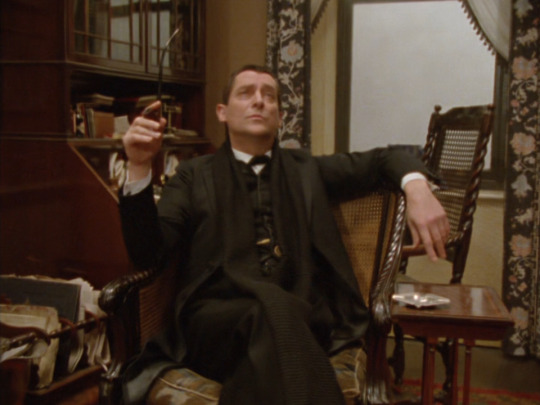

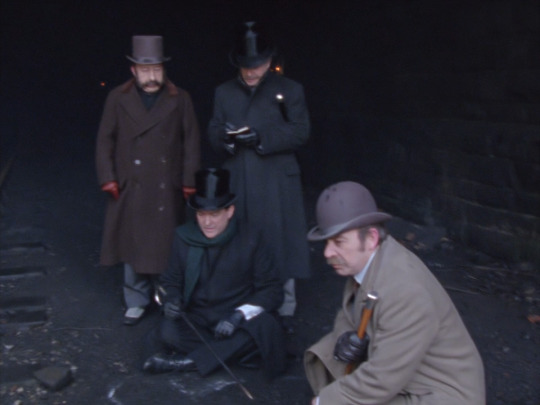



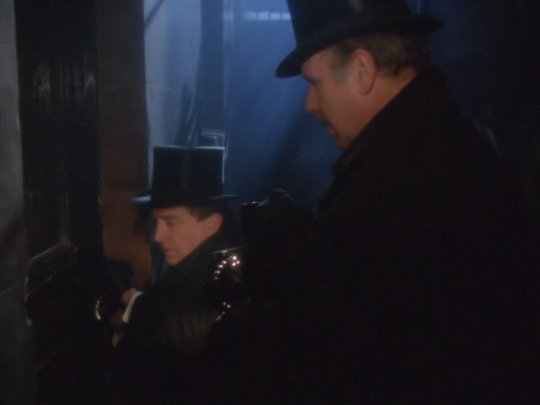

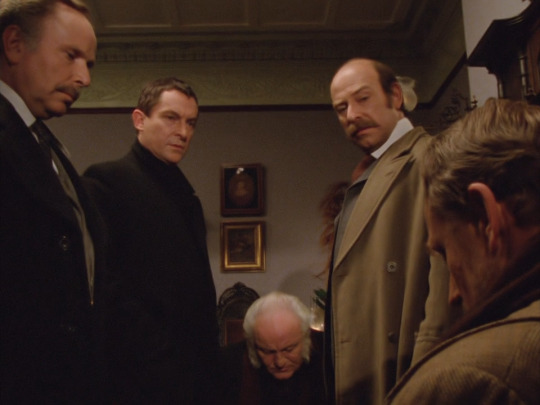

The Bruce Partington Plans (1988)
Сам рассказ находится в сборнике по соседству с несколькими более слабыми поздними работами АКД, но тем не менее является отличным образцом шерлокианских рассказов! Гранадовская экранизация тоже получилась весьма бодрая (по сравнению с предыдущей “Сиреневой сторожкой”), да еще и с множеством дополнительных сценок и фразочек, за что я так и люблю гранаду. В начале Холмс рассекает в зеленом шарфике даже дома, напевает и страдает из-за отсутствия достойных его преступлений. А потом заявляется его брат Майкрофт с делом о чертежах Брюса-Партингтона. (А я еще до выхода сериала “Шерлок” шутил, что в современном мире чертежи “увели” бы просто на флэшке). Все расследование шло вполне по канону, но нам добавили очаровательного Холмса, который не может разобрать братов почерк и то хвалит миссис Хадсон, то раздражается и велит ей исчезнуть (а что она посуду неубранной оставляет - некуда карту расстелить!). Единственная мое сожаление в этой серии - как-то скомкали сцену в ресторане, где у Холмса в глазах появилась нежность. Там скорее были радость и восторг, чем более тонкие чувства. Ну зато здесь было в полной красе очередные взлом и проникновение (дай бы волю Холмс бы этим целыми днями занимался, из спортивного интереса, конечно же). А потом, помимо очаровательного утреннего Холмса в ночной рубашке за завтраком (при Майкрофте и инспекторе), была поимка злодея, которая, если честно, не вызывает у меня каких-либо особых чувств.
9 notes
·
View notes
Photo

Today, August 29, is the birthday of Charles Gray, who played Mycroft Holmes in the Jeremy Brett Granada series. In addition to appearing in the two canon stories “The Greek Interpreter” (The Adventures of Sherlock Holmes, 1985) and “The Bruce-Partington Plans” (The Return of Sherlock Holmes, 1988), he was also seen in two episodes of The Memoirs of Sherlock Holmes (1994): “The Golden Pince-Nez” (due to Edward Hardwicke (Watson)’s absence) and “The Mazarin Stone” (due to Brett’s illness, and combined with pieces of “The Three Garridebs” story).
He had previously appeared as Mycroft in the film adaptation of The Seven-Per-Cent Solution as well as the arch-villain Blofeld in Diamonds Are Forever (against Sean Connery) and the Criminologist in The Rocky Horror Picture Show.
Gray passed away on March 7, 2000.
8 notes
·
View notes
Text
BBC Radio Sherlock Holmes Bruce Partington plans was broadcasted in 1994, so idk it was by accident or deliberate nod to the episode adapted by the same story from Granada Sherlock Holmes (1988) in which Holmes sings out of boredom.
15 notes
·
View notes
Text
Can I Be of Assistance? BBC Sherlock and The Secret of Sherlock Holmes
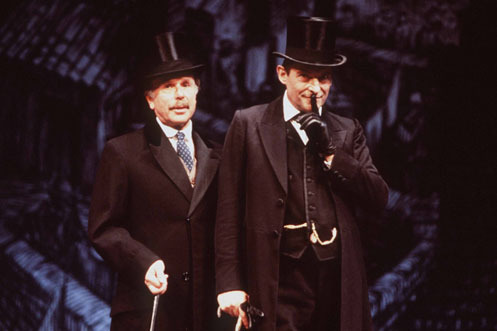
The Secret of Sherlock Holmes was a play written by Jeremy Paul, who also wrote several episodes of the Granada series. Paul and Jeremy Brett, who had been friends for two decades before this play was produced, would often talk about Sherlock Holmes and his origins. During one of these discussions, Brett commissioned this play from Paul; it contains many of Brett’s own theories about the character so many people identified with him. The play was meant to be a one-off, starring Jeremy Brett and Edward Hardwicke in their famous roles, in celebration of the 100th anniversary of A Study in Scarlet. However, it was met with such enthusiasm that it ended up running for a full year (1988/1989), rather to the detriment of Brett’s health.
As a refresher, the Granada series ran from 1984 to 1995. The first season ended with The Final Problem, and the second ended with The Bruce–Partington Plans (episodes did not follow the order of Watson’s writings or any chronological order of occurrence). The play ran between the second and third seasons.
There will be lots of spoilers below the cut, so if you’d like to experience the play before reading, please click here for an audio recording of the original performance in two parts. Unfortunately, the play was never filmed. Also unfortunately, the audio becomes very poor around 19:20 in the second audio link. I promise it never gets loud again after that (except an exclamation or two by Jeremy Brett, of course!), so feel free to turn up your volume.
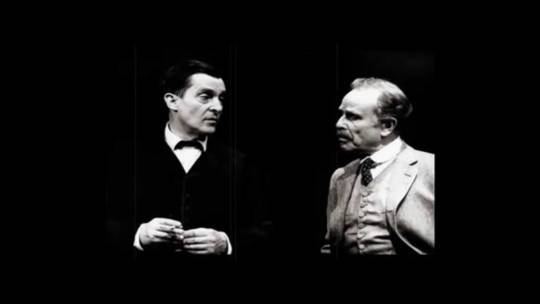
Before I read The Secret of Sherlock Holmes, I expected it to be entirely in keeping with the Granada series. It’s not. The series and the play differ in tone and content. There are no cases, and Holmes and Watson are the only characters. Stories that had already been adapted in Granada turn up in the play in different forms, but only to serve their relationship. The play adapts the subtext of the stories, rather than the text, which is something Granada rarely did, and mainly in the later episodes, like The Eligible Bachelor.
In the context of Sherlock, this means that The Secret of Sherlock Holmes is a greater source than the Granada series was, because the play was original in ways that the series wasn’t (perils of being faithful to the surface narratives of the stories). I’m going to talk about how the play adapted the Doyle stories, and how those choices are reflected in Sherlock, because as we know, “Everything is canon”.
The play develops the Holmes and Watson relationship from the time they meet and move in together, until some time after Holmes returns to Watson after faking his death in the Reichenbach. Along the way, they each address the audience to tell us secrets they keep from each other; the action (so to speak) culminates in a discussion of Moriarty’s role in their lives.
Love, loss, lies, and John Watson being pretty damned smart, under the cut.
We open with Watson describing himself in humble terms, to be interrupted by Holmes praising his role in the war. When Holmes turns to the audience, his tone changes, and he contradicts what he’d said publicly.
HOLMES (privately): The fact is, the man I met in the chemical laboratory at Bart’s was exhausted, penniless and deeply disillusioned.
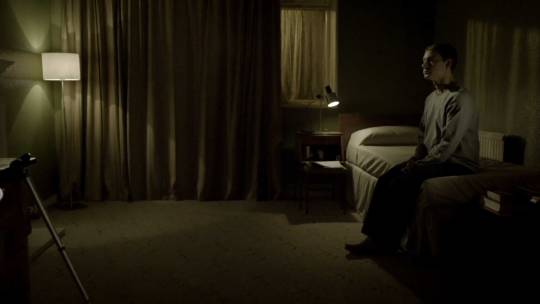
So, by the time we hear Watson describe their lodgings at 221B, we’ve got some emotional context.
WATSON: Holmes was looking for someone to go halves with him in some lodgings he’d found… which were too much for his purse.
This is probably not true. But did Holmes lie to Watson, or is Watson lying to us? This is a question we must ask ourselves repeatedly during this play. The canon references sometimes provide clues to what information we can trust, but not always.
Holmes and Watson move in together, and Watson is yelled at for trying to sit in Holmes’ chair. Watson tests Holmes’ deductions using his father’s watch, and learns of Holmes’ mind palace attic and his gift for disguise. Immediately after he explains to Watson his disdain for the solar system, we see him shoot up for the first time.
HOLMES strides upstage. The mood and the lights change. Music. With his back to the audience, HOLMES slips off his jacket, rolls up his shirt-sleeve, flexes his arm and ‘injects’ himself with cocaine. WATSON, seated with his newspaper, becomes aware and disturbed by his friend’s action. As the drug takes effect, HOLMES lets out a small cry of relief. WATSON addresses the audience, quietly.
WATSON: When first I discovered his habit, I was appalled. Being a medical man I knew the damage, which brought more peril to my friend than all the storm of his tempestuous life. And yet I found that I lacked the courage to protest. Again and again I registered a vow that I should deliver my soul upon the subject.
WATSON retires behind a book. HOLMES comes furtively to the front of the stage and speaks privately his innermost thoughts.
HOLMES: If it wasn’t for Watson, I would have been dead within two years. A man needs a companion, he cannot sit alone… With his silent reproaches, his hurt looks, Watson controlled my addiction. And our walks, our conversations… the sheer breadth and enthusiasm of his mind on any manner of subjects kept me sane when the black fits were upon me. There never was a better friend. And I treated him abominably.

“John Watson, you keep me right.” (The Sign of Three)
But that’s quite a condemnation he closes this aside with. How did Holmes treat Watson abominably? This passage is rapidly followed by two events: his engagement to Milverton’s maid and his fascination with Irene Adler.
And here is where I miss seeing my Watson. Hardwicke plays Watson’s reaction to Holmes’ engagement with a bright “My dear fellow, congratulations!” The engagement appears to have been played off for a laugh, which is completely at odds with what we just heard Holmes tell us privately. I wonder if Hardwicke’s expression might have betrayed a different reaction, because as I read the scene, I certainly pictured this:

But I don’t hear it in the audio recording of the performance.
Irene Adler is, of course, introduced to us by Watson. Here we have the most direct confrontation of Watson’s statements about Irene that we ever hear, from Holmes himself.
WATSON: There was only one woman in Holmes’ life. Her name was Irene Adler. She was an opera singer from New Jersey, mistress to a king and quite one of the most ravishing beauties I have ever seen. (Moves around stage left) It was not that Holmes felt any emotion akin to love for her. For a trained reasoner to admit such intrusions might throw a doubt upon all his mental results. But when he speaks of her or when he refers to her photograph it is always under the honourable title of the woman.
HOLMES, still on the couch, breaks the mood impatiently.
HOLMES: Watson! These little records you keep of our cases… I cannot congratulate you upon them. Detection is, or should be, an exact science and should be treated in the same cold and unemotional manner. You have attempted to tinge them with romanticism, which produces much the same effect as if you worked a love-story or an elopement into the fifth proposition of Euclid.
I love that they pulled Holmes’ complaint verbatim from The Sign of the Four, about the inaccuracies in Watson’s version of A Study in Scarlet, to create this rebuttal of the Irene Adler description. There follows a heartfelt discussion, ostensibly about Watson’s description of the cases, whether Holmes has “failures”, and whether these should be reported to the public. Hardwicke again plays his reaction to Irene subtly, if at all. Does his written hyperbole about her relationship with Holmes show discontent? Or did Holmes simply overestimate Watson’s affection for him when he labelled his own actions as “abominable”? I think Holmes was left wondering about this, too.
We move quickly to a train carriage, with Holmes looking out the window at the houses going by. However, instead of musing on “their isolation and of the impunity with which crime may be committed there”, as one might expect from The Copper Beeches, he talks about the children in these houses as “bright little seeds”, and segues to a private aside about his and Mycroft’s upbringing.
HOLMES: The cruelty of parents… to their children. My brother and I… forced… by accepted convention of upbringing… into such a frosted, trapped, inhibited dark corner… that we could not even communicate with each other. My father, absent, though never far away. We heard his step, his voice, but I scarcely exchanged a word with him before I was twelve. And mother, poor creature, starved of affection, yet I never saw her cry, not once. That vicious nurse! That house! The terror of silence…
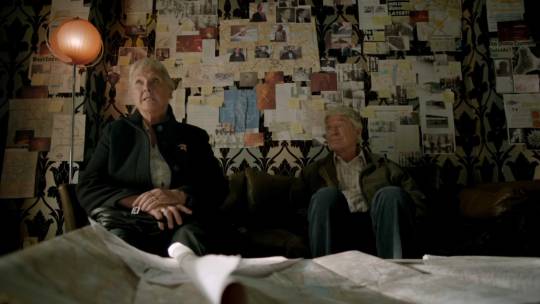
Charming people, these. I keep waiting for the other shoe to drop. Holmes doesn’t let Watson in on any of this history.
HOLMES (privately): How much one conceals from a friend... even a friend as close to me as Watson, how much one covers up. (To WATSON) It was, Watson, vividly alive!
WATSON (to audience): It pleases me when Holmes feels he can talk frankly about himself. It removes the impression he gives to others, and to myself, I confess, at times, that he is an isolated phenomenon, a brain without a heart, as deficient in human sympathy as he is pre-eminent in intelligence.
This perfect illustration of the division between them, despite their closeness, is the last exchange we are shown before Watson announces his engagement to Mary Morstan. And where we had to struggle to see Holmes’ “abominable treatment” of Watson via interloping women, the reverse all too painfully clear.
HOLMES: Good luck... (The mood and lights change) Mary Morstan is delightful. And very good for Watson, I’ve no doubt. (Sits in WATSON’s chair, hums a tune, makes finger movements for the violin and then flexes his arm, mindful of cocaine) I am lost without my Boswell.
HOLMES is suddenly, intensely alone. WATSON returns downstage, to the audience.
WATSON: During the first months of my marriage I have seen little of Holmes. My own complete happiness and home-centred interests are sufficient to absorb all my attention, while Holmes, who loathes every form of society with his bohemian soul, remains in our lodgings in Baker Street... (Moves past HOLMES, who stays seated, oblivious to his presence) alternating between cocaine and ambition, the drowsiness of the drug and the fierce energy of his own keen nature.
And now the impossible happens. We see Holmes conjure up Moriarty out of thin air; he appears as a shadow stretching across the stage, as the lights and music grow dark and troubling.
HOLMES is alert, afraid.
HOLMES: Professor Moriarty, I presume...? (The shadow remains. Silence.) When the time is right, my friend, when the time is right...
In an early staging of the play, before it was shown to the general public, Jeremy Paul played the shadowy Moriarty figure himself.
At one point in the proceedings, Paul chugged around the stage trying to evoke a Victorian locomotive! ... Some changes were made before the play was offered for mass consumption. Jeremy Paul's onstage antics were derailed, leaving just Brett and now Edward Hardwicke as Holmes and Watson--no narrator, no shoeless Moriarty impersonating a choo-choo. [x]
I’m relieved that they ended up making Moriarty a disembodied voice, because this would have been ridiculous, no? I can’t even picture what that would be like. Nightmarish, probably.

“Choo-choo!” (The Final Problem)
Right. Back to the staged version.
The shadow moves away. WATSON’s voice is heard.
WATSON: Holmes? (HOLMES stays perfectly still) Can I be of assistance?
HOLMES: Your presence might be invaluable.
Watson’s disembodied voice asks Holmes what he’s afraid of, and Holmes finally tells him, in a “terrifying shriek”: Air-guns!
The real Watson finally enters, bringing a cake from Mary (cake is code for violent death [x] [x] ... sure, that just came out of thin air), and I think the idea of making Mary Morstan into Sebastian Moran the air-gun assassin originated right here.
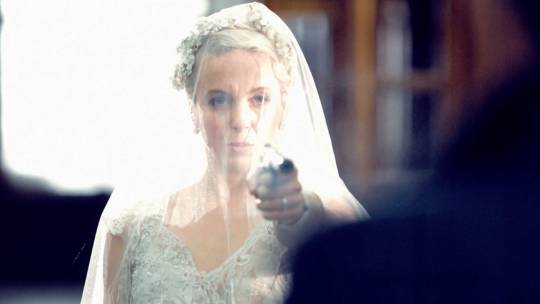
Because Jeremy Paul’s play makes it pretty clear: the arrival of Mary Morstan made Holmes crave death. Whether or not Moriarty is real in the universe of this play (and I think that remains uncertain), Mary pushes Holmes into his arms and over the falls.
Holmes politely sets the cake tin aside and proceeds to tell Watson about Moriarty and the threat he presents. He’s agitated, and Watson recognizes the symptoms.
WATSON can take no more. He interrupts angrily.
WATSON: What was it today? Morphine or cocaine?
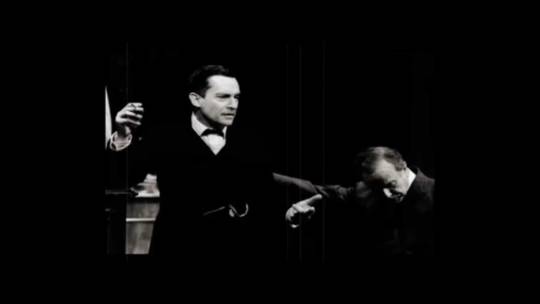
They argue passionately and at length about the drugs, and then part.
Time passes, and Holmes visits Watson at his house, asking to stay the night. When he learns that Mary is not at home, he demands that Watson follow him to Switzerland for a week. Watson agrees, and we are suddenly at Reichenbach.
As we listen to Watson eulogize Holmes, we wonder: was Moriarty ever there? Or did Holmes just attempt suicide for real? As Watson sits alone, the lights come up on Holmes, reciting the rose soliloquy from The Naval Treaty. And here’s at least part of our answer – because that passage, which so many readers take as evidence of Holmes’ humanity or his faith, was a big fat lie, to cover the collection of evidence. We now know Holmes faked his death... or at least, we know that’s what he’s telling us. Whether Holmes is telling us the truth or a lie, he’s not telling Watson anything, although Watson does seem to sense his presence.
The light fades on HOLMES and returns to WATSON, who raises his head from his hands.
WATSON: Holmes?
HOLMES (a disembodied voice): I am here, my friend.
WATSON (not hearing): Holmes? Can I be of assistance?
His question is met by a faint echo of laughter from MORIARTY. WATSON is agitated. Alone. Knocks the ash from his pipe, and moves forward to his armchair. He is distressed.
I love how The Secret of Sherlock Holmes uses this echoed line from Watson, first, as a disembodied voice in Holmes’ mind; second, spoken to the Holmes that exists in Watson’s mind. It seems that whatever Holmes and Watson are keeping from each other, they can agree on this one thing: whatever the danger, Watson will always be there for Holmes. He will always want to help. It’s a damned tragedy that in every universe, Holmes won’t let him do it.
And the choice of this specific line is simply heartbreaking, because “Can I be of assistance?” is what Watson asked Holmes before they spent the night together in Helen Stoner’s bedroom in The Speckled Band. Of all the lines to quote from canon, Jeremy Paul chose this one to show just how Holmes and Watson miss each other after their separation. It says a lot about how he and Jeremy Brett viewed this relationship.
Watson tells us that Mary has died (interesting timing, as ever), and we hear him accept advice about sorrow from the Holmes in his mind, and he begins to write again: stories of loss from the beginning of Thor Bridge. Time passes; three years after Holmes’ death, he returns to Watson in his bookseller’s disguise. Watson faints, doing an excellent impression of his Granada counterpart. But when he wakes, his reaction is very different from that of Granada Watson.
He’s furious.
From one line to the next, Watson oscillates between vindictive anger and chagrin that he was not asked to help. As the stage directions say explicitly, he’s in shock. Holmes is at first surprised at the hostile welcome, and then unsure. This is not going the way he expected it to. It’s not going the way the audience expected it to, either. When they last watched Edward Hardwicke’s Watson welcome Holmes back from the dead, it looked like this:
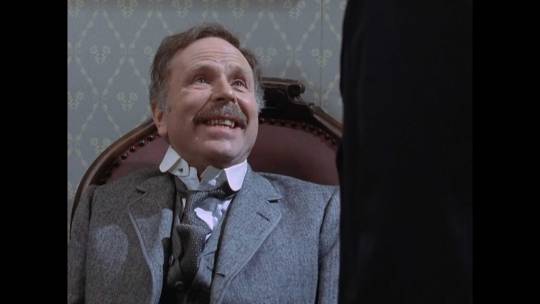
“I can hardly believe my eyes!” (The Empty House)
The play’s Watson looks a great deal more like this:

... (The Empty Hearse)
HOLMES has risen, but WATSON walks abruptly from the room. HOLMES stares after him in amazement, then sits down again, fully aware that he has misjudged the depth of his friend’s feelings. After a moment WATSON re-appears. A further silence, then WATSON lets loose:
WATSON: Did you value our friendship as little as that? Whatever your reason I could have accommodated it. Just a word, a simple note. (HOLMES tries to interrupt, but WATSON won’t allow it) Can there be any secret so precious that a man could allow his closest friend to believe he was dead for three whole years? (A pause. WATSON makes an effort to keep his emotions on a tight rein) Consider the reverse. If I disappeared without a word to you, would you not take it as a trifle unfeeling of me?
HOLMES: I would have considered it uncharacteristic. I would have examined the data, and drawn conclusions.
WATSON: Coldly, without emotion?
(A pause)
Holmes offers to explain, asking for forgiveness. Watson allows it. They discuss the details of the Fall, with Watson stopping him periodically for clarification. This Watson wants to know how as much as he wants to know why. Once Holmes has completed the tale, they sit in silence.
And then something very interesting happens.
Watson begins to tell Holmes stories about the time he was away. Investigating that Watson did on his own. He spins a very long tale, ending (through Mycroft’s surprising incompetence at keeping secrets) with his figuring out that Holmes did not die at Reichenbach at all, and with Watson waiting years for Holmes to contact him, before finally concluding that Holmes must have died sometime after Reichenbach, because he never returned. That’s why he fainted, Watson explains.
Watson is smarter than he looks, it seems. Holmes is deeply impressed, and tells Watson his own tale about his time away, in places we’ve heard of, but mainly his time in Tibet with the Dalai Lama. They patch things up, and Watson agrees to move back into 221B. While he is away packing, Holmes speaks to us.
HOLMES: There are certain people to whom one cannot lie. My friend is one of them. And yet there are certain truths that cannot be told... easily. (A pause) Sometimes one longs to be found out.
Of course, we have already seen Holmes lie to Watson, so this is intriguing. Why would he lie to us? Aren’t we here to keep their secrets? In what way does he want to be found out?
They settle in by the fire, and talk of French grandmothers and bees, until Holmes goes to the window and sets Watson a test: deduce the woman across the street. Watson misses everything of importance: if he had ever acquired deductive superpowers in Holmes’ absence, they appear to have left him. Holmes’ mood changes, and Watson misdiagnoses.
WATSON: Life is infinitely stranger than anything which the mind of man could invent, don’t you think, Holmes?
The lights dim to reflect HOLMES private thoughts.
HOLMES: Yes... if we could fly out of that window had in hand, hover over this great city, gently remove the roofs, and peep in at the strange coincidences, the plannings, the cross-purposes, the wonderful chain of events, working through generations, and leading to the most outré results, it would make all fiction, with its conventionalities and foreseen conclusions, most stale and unprofitable. (HOLMES puts his hand to his head, whispers) Irene... Irene...I can still catch the fragrance of her scent.
They talk about Irene briefly, then her death (recall that Watson told us she had died within four years of the events of A Scandal in Bohemia) and Mary’s. Holmes’ mind turns from Mary to Moriarty, naturally. Watson tells him that Moriarty’s brother James defended him in the press after Reichenbach, forcing Watson to in turn defend Holmes’ reputation by publishing his story.
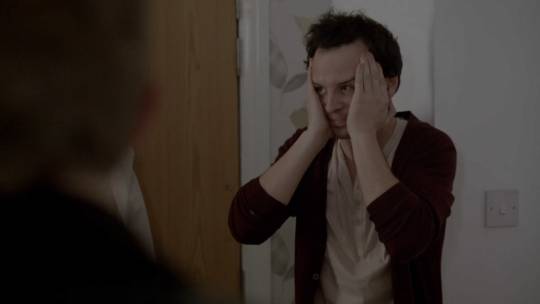
Holmes responds to this by adopting a number of his famous disguises for Watson to identify, ending with... James Moriarty. Watson doesn’t buy it, and why should he? If Holmes and Moriarty were the same person, why would he write the press from beyond the grave to trash his reputation as Holmes, especially if he faked his death to destroy the Moriarty half of his personality in the first place? It doesn’t make sense.
Holmes rushes about the stage and then collapses, to Watson’s alarm. When the lights come up, Holmes is raving:
HOLMES: Oysters! Oysters! Shall the whole bed of the ocean be overrun by them? Are there not natural enemies which limit the increase of these creatures?
Because we’ve read The Dying Detective, we recognize this as his fake hallucination speech. Lying again, then. But how much of what he told Watson was a lie? And how much of what follows?
Watson is very concerned, but Holmes will not let him treat him with medicine. Instead, he says he needs Watson’s powers of logic and deduction to cure him. He offers Watson a hypothesis: that Moriarty exists only because Holmes invented him. That Holmes ran Moriarty’s criminal network, with Mycroft’s help, from within 221B, meeting clients while Watson was in his upstairs room, in order to keep abreast of what was happening in the underworld. Some shady acts were committed, but all in the name of the greater good. He commissioned, under the name Moriarty, the manufacture of the very air-gun that was to assassinate him under the name Holmes.

“You’re me!” (The Reichenbach Fall)
Holmes says that he eventually realized that he could not sustain the two opposing personalities; he decided to kill the Moriarty persona at Reichenbach and seek healing in Tibet.
WATSON: And what did you find?
HOMES: Intolerable loneliness. And no solutions. And nothing to exercise my mind. Beyond the arid abstractions of philosophy. [...] I was out of my element. I missed the thronging streets of London, and your companionship.
A pause. WATSON is now seated in HOLMES’ chair.
WATSON: I, too... was out of my element.
Holmes explains that the Lama told him that he had a price to pay for killing his darker self; that his friend and enemy were one.
WATSON: Now I am Moriarty?
HOLMES (smiles): There was a language problem. But his meaning was clear. You cannot have Watson without Moriarty. And without both of them, there is no Holmes. The three of us are inextricably bound, you see.
WATSON (steadily): But Moriarty is dead. You killed him.
HOLMES: Oh yes. I killed him. At Reichenbach. As you so faithfully recorded. And I know exactly what he’s going to do next.
WATSON: That is the truth?
HOLMES is back in WATSON’s chair. He speaks with quiet desperation.
HOLMES: The absolute truth. Do you believe me?
WATSON: I have always believed you.
They make peace again, and as Holmes adopts the lotus position, a client waits on the doorstep. Normal life is about to resume.
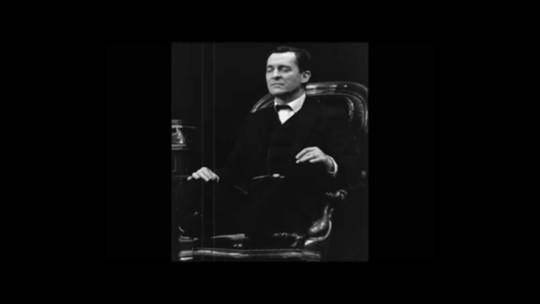
Is Brett’s Holmes summoning a Moriarty successor in that final scene, or trying to keep one at bay? We’ll never know. But in this context, I find it interesting that Victorian Sherlock takes the same position, along with a syringe, to summon Moriarty in The Abominable Bride.
[There was an interesting meta recently that explored the idea that based on these poses, Sherlock could be in a trance for S4, which I’ll link here in case anyone wants to take a look (part 1, part 2).]
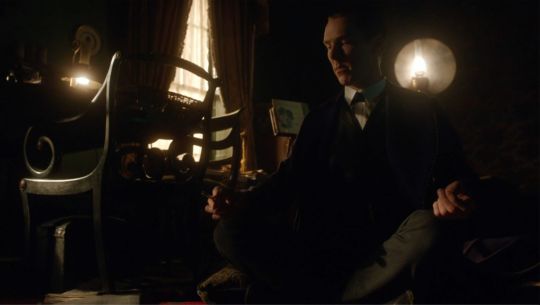
The questions that I’m left with after the play ends, just like after S4 of Sherlock, are about the nature of reality. How much of what we heard was true? Is Moriarty a real person, or is he Holmes’ creation? Is Holmes haunted by him because he exists solely in Holmes’ mind, or because he is so closely linked in his mind to the loss of Watson to Mary?
Similarly, did Watson really deduce that Holmes had faked his death? That story, about the details he picked up (a skill he couldn’t later demonstrate on demand) and the “very limited” nature of Mycroft’s ability to hide his own tells (which included tapping the fingers of his left hand – adopted in the BBC series as a Watson tell) was incredible. Literally incredible – I can’t believe it.
And why did Holmes and Watson switch chairs while discussing Moriarty? Paul made a point of establishing these as territory when Holmes and Watson first moved in together. The chairs are important.
And so, finally, I find myself asking: is it possible that the real question is not about whether Holmes is Moriarty, but whether Holmes is Watson? Because, of course, all of these stories are Watson’s stories. And in a passage near the end of the play, Watson somehow quotes Holmes’ soliloquy about flying above rooftops. How can he do that?
WATSON: Can we not feed off the stories beneath the roofs... of ordinary people, peep in at the strange coincidences, the plannings, the cross-purposes, the wonderful chain of events... leading to the most outré results?
HOLMES (amused): Did you say that? I seem to hear my voice.
WATSON: Your voice, my voice... they are inextricably bound, aren’t they, Holmes?
HOLMES: You are developing an unexpected vein of pawky humour, Watson, against which I must learn to guard myself. Will you be entrusting to print these secrets we’ve shared this evening... verbatim?
WATSON: I shall, as always, respect your wishes, Holmes, and select... and hone... and transpose... and omit... and, I hope, fulfill the expectations of your adoring public.
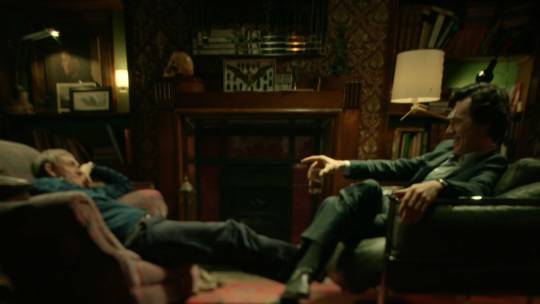
“Got it. I’m you, aren’t I?” (The Sign of Three)
This resolution would put a very interesting spin on the creation of Moriarty upon Watson’s marriage to Mary, and their virtually simultaneous deaths. It would also explain why Watson’s reactions to events that Holmes finds painful lack the poignancy that we would expect: he funnels that emotion into Holmes’ character, leaving himself blameless. And this turns the Tibetan triangle on its head: if Watson must marry, and as he implies early on, he must marry for the sake of his practice, then Watson must also have a Sherlock Holmes to bear the loss of what he misses.
But if that is the final secret of The Secret of Sherlock Holmes, it’s unfortunately one that Jeremy Paul and Jeremy Brett must keep.
These are, of course, my interpretations of the play, but I fully expect other people to take different things from it. I love this play, and if I could, I’d probably trade every episode of the Granada series to be able to see a live performance with Brett and Hardwicke. I’d love to hear your impressions of the performance if you’ve seen or heard it. Comments welcome!
@may-shepard @green-violin-bow @tjlcisthenewsexy @ebaeschnbliah @monikakrasnorada @opaljade @sarahthecoat @221bloodnun @jenna221b @greencarnationwall @darlingtonsubstitution @materialofonebeing @granada-brett-crumbs @jeremyholmes @holmesianscholar @tremendousdetectivetheorist @inevitably-johnlocked @waitedforgarridebs @shamelessmash @sherlock-overflow-error @just-sort-of-happened @the-7-percent-solution @hawksmoor17 @sagestreet @bluebluenova
#Sherlock#Granada#The Secret of Sherlock Holmes#Jeremy Brett#Edward Hardwicke#Jeremy Paul#subtext in Granada Holmes#a rare and revealing treat#intertext#assassin Mary#cake is death#Moriarty#Rich Brook#TFP#John Watson#meta
514 notes
·
View notes
Text
#this whole video is very chaotic and I love it#daily dose of granada holmes#daily granada screencap#*video#victorian husbands#poor ms hudson#mrs hudson#sherlock holmes 1984#the bruce partington plans 1988#jeremy brett holmes#edward hardwicke watson#granada holmes#sherlock holmes#jeremy brett#edward hardwicke#sherlock holmes granada#dr john watson#john watson#acd holmes#acd sherlock holmes#acd watson#acd john watson
261 notes
·
View notes
Text
#i love them i love them so much#daily dose of granada holmes#daily granada screencap#*video#sherlock holmes 1984#the bruce partington plans 1988#jeremy brett holmes#edward hardwicke watson#granada holmes#sherlock holmes#jeremy brett#edward hardwicke#sherlock holmes granada#dr john watson#john watson#acd holmes#acd sherlock holmes#acd watson#acd john watson#I somehow just realized that I hadn’t finished this episode#I really don’t know how that happened but I could’ve sworn I’d finished it#what a pleasant surprise
260 notes
·
View notes
Text

“watson!”
#normal Holmes behavior#daily dose of granada holmes#daily granada screencap#sherlock holmes 1984#the bruce partington plans 1988#jeremy brett holmes#edward hardwicke watson#granada holmes#sherlock holmes#jeremy brett#edward hardwicke#sherlock holmes granada#dr john watson#john watson#acd holmes#acd sherlock holmes#acd watson#acd john watson
194 notes
·
View notes
Text
“Are you not the undertakers?”

#daily dose of granada holmes#daily granada screencap#*gif#sherlock holmes 1984#the Bruce Partington plans 1988#jeremy brett holmes#edward hardwicke watson#granada holmes#sherlock holmes#jeremy brett#edward hardwicke#sherlock holmes granada#dr john watson#john watson#acd holmes#acd sherlock holmes#acd watson#acd john watson
152 notes
·
View notes
Text
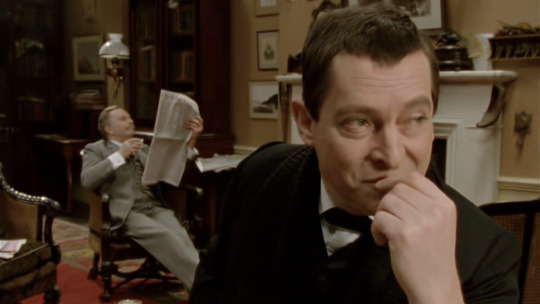
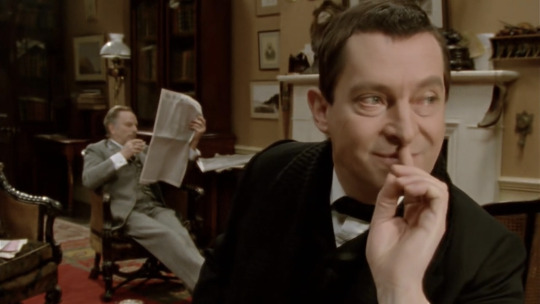
#daily dose of granada holmes#daily granada screencap#sherlock holmes 1984#the bruce partington plans 1988#jeremy brett holmes#edward hardwicke watson#granada holmes#sherlock holmes#jeremy brett#edward hardwicke#sherlock holmes granada#dr john watson#john watson#acd holmes#acd sherlock holmes#acd watson#acd john watson
148 notes
·
View notes
Text


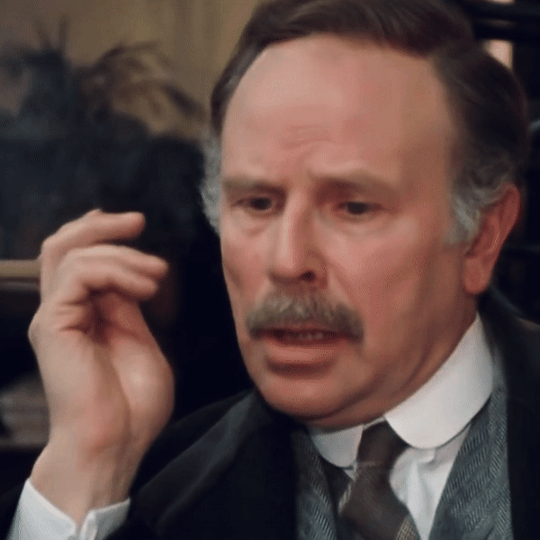

“I knew you wouldn’t shrink at the last!”
#the bruce partington plans 1988#sherlock holmes 1984#daily dose of granada holmes#daily granada screencap#*gif#granada holmes gifset#jeremy brett holmes#edward hardwicke watson#granada holmes#sherlock holmes#jeremy brett#edward hardwicke#sherlock holmes granada#dr john watson#john watson#acd holmes#acd sherlock holmes#acd watson#acd john watson#victorian husbands
122 notes
·
View notes
Text
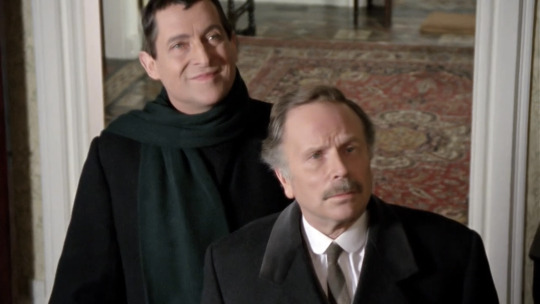
#daily dose of granada holmes#daily granada screencap#sherlock holmes 1984#the Bruce partington plans 1988#jeremy brett holmes#edward hardwicke watson#granada holmes#sherlock holmes#jeremy brett#edward hardwicke#sherlock holmes granada#dr john watson#john watson#acd holmes#acd sherlock holmes#acd watson#acd john watson
123 notes
·
View notes
Text


#daily dose of granada holmes#daily granada screencap#sherlock holmes 1984#the bruce partington plans 1988#jeremy brett holmes#edward hardwicke watson#granada holmes#sherlock holmes#jeremy brett#edward hardwicke#sherlock holmes granada#dr john watson#john watson#acd holmes#acd sherlock holmes#acd watson#acd john watson
135 notes
·
View notes
Text
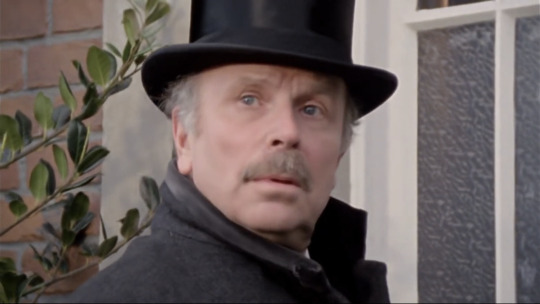
#another Watson appreciation post because I sometimes forget how much I like this guy#daily dose of granada holmes#daily granada screencap#sherlock holmes 1984#the bruce partington plans 1988#BRUC#jeremy brett holmes#edward hardwicke watson#granada holmes#sherlock holmes#jeremy brett#edward hardwicke#sherlock holmes granada#dr john watson#john watson#acd holmes#acd sherlock holmes#acd watson#acd john watson#Watson appreciation post
116 notes
·
View notes